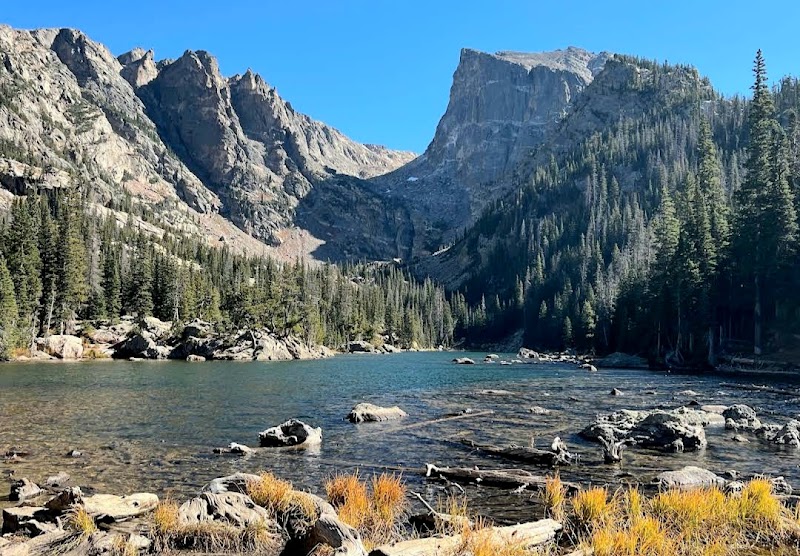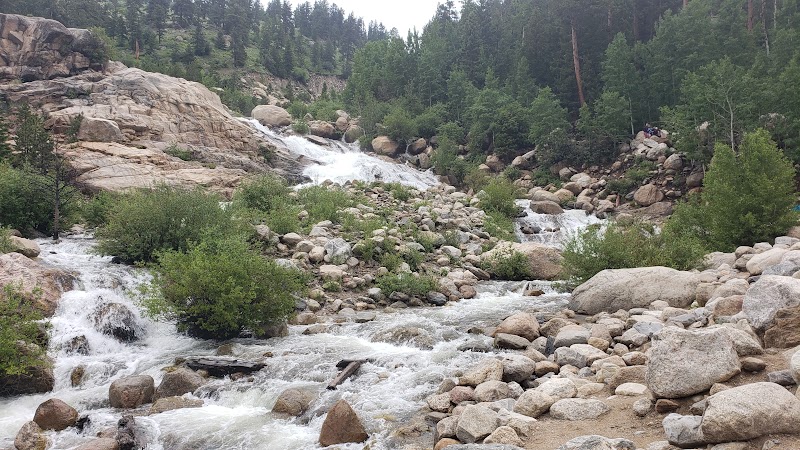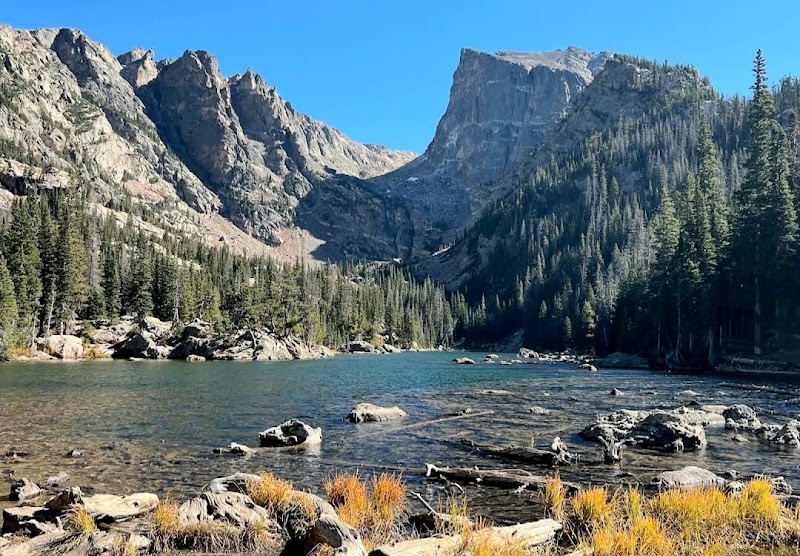Welcome to Rocky Mountain National Park
Embrace the natural grandeur at the Rocky Mountain National Park, a spectacle of nature that mesmerizes over 4.5 million visitors each year. The park is an amalgamation of majestic peaks, lush forests, and serene alpine lakes. It's a paradise for hikers and wildlife enthusiasts alike, where one can discover Trail Ridge Road, Bear Lake, and Longs Peak. Every step you take unveils a new spectacle, a fresh wonder waiting to be explored.
But, with such vast expanses to explore, where do you start? This is where the tourist map of Rocky Mountain National Park becomes your indispensable travel companion. It's your guide to the park's vast wilderness, leading you to unforgettable experiences. This map is more than just a guide; it's the key to unlock the treasures of Rocky Mountain National Park.
" Booking.comExploring the Unseen Corners of Rocky Mountain National Park
The well-trodden paths of Rocky Mountain National Park offer awe-inspiring views and experiences. Still, it's the unseen corners that truly captivate the adventurous spirit. Immerse yourself in the untouched beauty of these hidden gems, where the allure of nature's majesty is at its peak.
The Alpine Visitor Center
At the highest point accessible by vehicle in the park, you'll find the Alpine Visitor Center. Here, you are gifted with panoramic views that stretch out across the park's rugged landscape, a spectacle enhanced by the thin alpine air. The center itself is a testament to human resilience, standing firm amidst the harsh alpine environment.
The Wild Basin
Descend from the alpine heights to explore the lush, verdant area known as the Wild Basin. It's a lesser-known part of the park, offering tranquil hikes through the dense forest, past glittering waterfalls and serene alpine lakes. Be sure to bring your tourist map of Denali National Park as this area is a maze of trails, each leading to another hidden treasure.
Shadow Mountain and Grand Lake
Just beyond the park's western boundary, Shadow Mountain and Grand Lake provide a refreshing change of pace and scenery. The serene waters of the lake, nestled at the base of towering Shadow Mountain, offer a tranquil escape from the more crowded areas within the park. It's a perfect spot for boating, fishing, or simply soaking in the mountain vistas.
The Historic Holzwarth Site
Step back in time at the historic Holzwarth Site, where the remnants of an early 20th-century homestead offer a glimpse into the park's past. It's a testament to the resilience of the pioneers who braved this harsh landscape, their legacy preserved amidst the breathtaking beauty of the park. This site serves as a poignant reminder of the human history intertwined with the park's natural splendor.
Immerse Yourself in the Diverse Flora and Fauna
Rocky Mountain National Park is not just about the grandeur of towering peaks and glittering lakes. It's also a living testament to the diversity of life, with a plethora of flora and fauna that lend the park its vibrant pulse.
Bighorn Sheep and the Alpine Tundra
The alpine tundra, a landscape seemingly devoid of life, is in fact home to the park's iconic bighorn sheep. These magnificent creatures, perfectly adapted to this harsh environment, are a testament to the resilience of life at high altitudes. Keep your eyes peeled for these elusive denizens on your high-altitude explorations.
Wildflowers of the Montane Ecosystem
The montane ecosystem, characterized by sprawling meadows and dense forests, bursts into a riot of colors each spring. Witness the dazzling array of wildflowers, each species a vibrant thread in the intricate tapestry of this ecosystem. Come for the blooms, but stay for the hummingbirds, butterflies, and other wildlife that these flowers attract.
As you wander through the different zones of Rocky Mountain National Park, you'll discover it's more than just a collection of beautiful landscapes. It's a living, breathing entity, each corner teeming with life and echoing with stories from the past.

Practical Information for Your Trip to Rocky Mountain National Park
Transportation and Mobility
Getting around Rocky Mountain National Park can be an adventure in itself. If you're driving, the park has ample parking spaces but they tend to fill up quickly during peak season. Arriving early or visiting during off-peak hours can help you secure a spot. Alternatively, the park offers a free shuttle service during the summer months. The shuttle service runs from the Estes Park Visitor Center to various locations within the park, providing a convenient and eco-friendly option for transportation.
Schedules and Prices
Rocky Mountain National Park is open 24 hours a day, 365 days a year. However, certain areas and facilities operate on specific schedules. Visitor centers, for instance, are typically open from 8 a.m. to 4:30 p.m., but these hours can vary depending on the season. As for entrance fees, a 7-day pass for a private vehicle costs $35, while individual hikers or cyclists can get in for $20. Annual passes are available for $70, and all passes can be purchased online in advance or at the park entrances.
Safety Tips
While experiencing the beauty of the park, safety should always be a priority. Stay on marked trails to avoid damaging sensitive ecosystems and always keep a safe distance from wildlife. If you're planning on hiking, ensure you're adequately prepared with sufficient water, food, and suitable clothing. Weather conditions can change rapidly in the mountains, so check the forecast before setting off and be prepared for all eventualities.
Practical Recommendations
Timing your visit can make a significant difference in your Rocky Mountain National Park experience. Summer is the busiest season, so consider visiting in spring or fall for a less crowded experience. Morning hours are typically less busy than afternoons. Also, remember to pack a refillable water bottle, sun protection, and sturdy footwear. Even if you're visiting in summer, bring layers as temperatures can drop in the evening or at higher elevations.
For more detailed and updated information, check the official tourist guide to Glacier National Park.

Frequently Asked Questions about Rocky Mountain National Park
Even with all the information available, some unique queries about Rocky Mountain National Park might still be unanswered. Here are a few more specific questions that visitors often ask, with comprehensive answers to enhance your trip experience.
1. Are there any unique geological formations in Rocky Mountain National Park that I should see?
Yes, the park is home to several unique geological formations. The Alluvial Fan is a gem not to miss. It's a fascinating result of a natural dam break in the 1980s. The rushing water created a beautiful fan-shaped deposit of rocks and rubble. It's a testament to the raw power of nature and a sight to behold.
2. Can I take my pet with me to Rocky Mountain National Park?
Pets are allowed in the park, but with strict restrictions for their safety and the protection of wildlife. They must be on a leash and are not permitted on trails, along lakeshores, or in the backcountry. They are allowed in campgrounds, picnic areas, and along roadsides.
3. Are there any photography-specific spots in the park?
Yes, Rocky Mountain National Park offers some stunning locations for photography. The Many Parks Curve Overlook is a favorite among photographers for its panoramic views of the park's diverse ecosystems. Sunrise and sunset are particularly magical times to capture the beauty of the park.
4. What are some less crowded trails for a peaceful hike?
The Twin Sisters Peaks Trail and the Deer Mountain Trail are excellent choices if you're seeking solitude. They are less crowded than the popular Bear Lake or Emerald Lake Trails, yet offer equally breathtaking views.
5. Is it possible to see the park's night sky in all its glory?
Yes, Rocky Mountain National Park is a fantastic place for stargazing. The Glacier Basin Campground is a popular spot for night sky viewing, thanks to its high elevation and minimal light pollution. Remember to check the weather forecast for clear skies.
6. Are there any winter-specific activities in the park?
During winter, Rocky Mountain National Park transforms into a snowy wonderland offering unique activities. Cross-country skiing and snowshoeing are popular, and the park provides guided tours for both. You can also enjoy sledding at the Hidden Valley Play Area.

